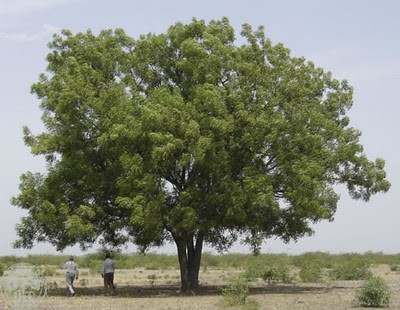Articles written in Sanskrit are proof that people have been using neem for thousands of years. Neem seeds are pressed and what oozes out is neem oil. But starting in 2005, research scientists found a way to extract the pure neem extract from neem seeds – capturing 93% of the bioactive ingredients from the Neem trees in Africa.

Neem Seeds
This pure neem extract is a highly concentrated liquid that is mixed with water [two drops per one ounce of water] and applied to plants as a foliar spray once a week. The plants quickly transform and take on the properties of robust and healthy neem trees from Africa. Over centuries, these trees have evolved and adapted to survive and even thrive in the harshest climates on earth—such as sub-Saharan Africa. Many times these trees are visible whenever you see an African safari on TV. You observe the dry desolate landscape and then, in the middle of nowhere, you see a giant, lush, green tree. They are absolutely loaded with bioactive nutrients, and have an active ingredient called Azadirachtin that protects it from harmful pests. When a locust swarm passes through eating everything in sight, the only plants left are the ones with Azadirachtin. Azadirachtin does not poison the insects like a pesticide; instead, it triggers a stop eating response and the bugs will ultimately starve to death. Harmful pests have learned that they don’t want to be anywhere near these plants, so they avoid them. African villagers also like to gather under these trees because they provide the best shade (they remain green all year) and there are no bugs anywhere near them.
Neem Tree
Extracts from the neem tree are often used to treat a variety of insect problems. Pests that can be treated with them include: aphids, beetles, cockroaches, flies, fruit flies, fungal infections, grasshoppers, leaf miners, mosquitoes, moths, nematodes, snails, spider mites and thrips. Neem is an EPA-approved pesticide that is not only fairly non-toxic to people and animals, but also to beneficial insects including bees.
Azadirachtin is reportedly similar in structure to the hormones used by insects to control development. Once introduced, it blocks the normal functioning of these hormones and prevents the insects from becoming sexually mature. It is also responsible for a fair amount of neem’s repellant properties. Neem also contains the limonoids salannin and meliantriol (both inhibit feeding) and nimbin, which has antiviral properties.
The extraction process is complicated, but the basic concept is simple: capture the biotechnology of robust, healthy trees (Neem) that have adapted to the harsh climates of sub-Saharan Africa and transfer those properties to plants grown in the United States.
James E. Kostrava, is CEO & Founder of Organibliss, LLC.
Related Articles & Free Email Newsletter Sign Up
Azadirachtin and Neem: What is the Difference?
Natural on the Label Doesn’t Always Mean Safe




Comment here